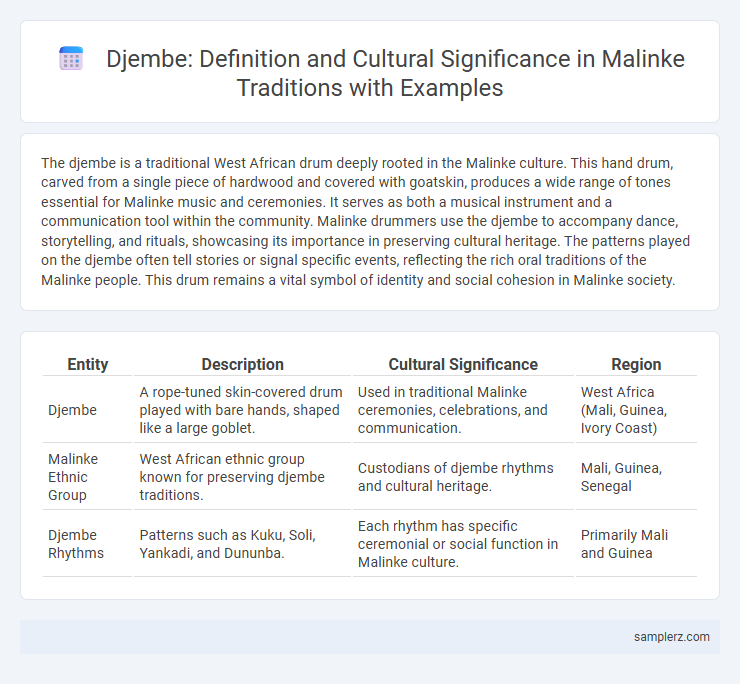The djembe is a traditional West African drum deeply rooted in the Malinke culture. This hand drum, carved from a single piece of hardwood and covered with goatskin, produces a wide range of tones essential for Malinke music and ceremonies. It serves as both a musical instrument and a communication tool within the community. Malinke drummers use the djembe to accompany dance, storytelling, and rituals, showcasing its importance in preserving cultural heritage. The patterns played on the djembe often tell stories or signal specific events, reflecting the rich oral traditions of the Malinke people. This drum remains a vital symbol of identity and social cohesion in Malinke society.
Table of Comparison
| Entity | Description | Cultural Significance | Region |
|---|---|---|---|
| Djembe | A rope-tuned skin-covered drum played with bare hands, shaped like a large goblet. | Used in traditional Malinke ceremonies, celebrations, and communication. | West Africa (Mali, Guinea, Ivory Coast) |
| Malinke Ethnic Group | West African ethnic group known for preserving djembe traditions. | Custodians of djembe rhythms and cultural heritage. | Mali, Guinea, Senegal |
| Djembe Rhythms | Patterns such as Kuku, Soli, Yankadi, and Dununba. | Each rhythm has specific ceremonial or social function in Malinke culture. | Primarily Mali and Guinea |
Origins of the Djembe in Malinke Culture
The djembe drum originates from the Malinke people of West Africa, specifically within the Mandinka ethnic group of present-day Mali, Guinea, and Ivory Coast. Traditionally carved from a single piece of hardwood and topped with goat skin, the djembe holds deep cultural significance in Malinke ceremonies, storytelling, and social gatherings. Its rhythms embody spiritual connections and communal identity, reflecting the rich oral history and artistic heritage of the Malinke culture.
Traditional Roles of the Djembe Among the Malinke
The djembe holds a central role in Malinke culture as a traditional drum used for communication, storytelling, and ceremonial purposes. Skilled djembe players, known as djembefolas, facilitate community cohesion by performing rhythms that accompany dances, rites of passage, and spiritual rituals. This drum's deep cultural significance reflects the Malinke's oral history and social structure, preserving ancestral knowledge through its distinctive sounds.
Symbolic Meaning of the Djembe in Malinke Society
The djembe drum in Malinke society symbolizes unity and communication, serving as a vital tool in ceremonies and social gatherings. Its intricate rhythms convey ancestral stories and spiritual messages, reinforcing communal identity and cultural heritage. Crafted traditionally from African hardwood and goatskin, the djembe embodies the connection between the physical and spiritual worlds in Malinke culture.
Construction Techniques Unique to Malinke Djembe
The Malinke djembe features a unique construction technique distinct from other West African drums, including the use of a single hollowed-out hardwood trunk combined with a goatskin drumhead tightly secured by hand-woven rope tuning systems. Artisans utilize locally sourced lenke wood for its durability and resonance, shaping the drum body with traditional hand tools to preserve cultural authenticity. The intricate rope tensioning allows precise sound modulation, crucial for the drum's distinctive tonal range in Malinke ceremonial music.
Rituals and Ceremonies Involving the Djembe
The Malinke people use the djembe drum extensively in rituals and ceremonies, where its deep, resonant tones invoke spiritual connections and communal unity. During rites of passage such as weddings, funerals, and initiation ceremonies, the djembe's rhythms guide dancers and signal transitions in the ritual process. The drum's patterns are deeply symbolic, often calling upon ancestral spirits and reinforcing cultural identity within the Malinke community.
Famous Malinke Djembe Rhythms and Patterns
Famous Malinke djembe rhythms such as Kuku, Yankadi-Macru, and Soli are integral to traditional ceremonies and social gatherings, showcasing complex polyrhythmic patterns that emphasize call-and-response structures. Each rhythm carries cultural significance: Kuku celebrates community and harvest, Yankadi-Macru is associated with praise and healing, while Soli honors warriors and funerary rites. Mastery of these patterns demands intricate hand techniques and deep understanding of Malinke cultural narratives conveyed through the djembe's dynamic tonal range.
Leading Malinke Djembe Masters and Griots
Leading Malinke djembe masters such as Famoudou Konate and Mamady Keita have preserved and promoted the intricate rhythms and techniques essential to Malinke cultural identity. Griots, traditional Malinke storytellers and musicians, utilize the djembe to accompany oral histories, ceremonies, and social events, reinforcing communal bonds through rhythmic storytelling. This dynamic interplay between master drummers and griots sustains the vibrant cultural heritage of the Malinke people across West Africa.
Teaching and Transmission of Djembe Skills in Malinke Communities
In Malinke communities, the teaching and transmission of djembe skills occur through oral traditions and hands-on apprenticeship, where seasoned drummers mentor younger generations in rhythms and techniques integral to cultural identity. Master drummers emphasize the importance of call-and-response patterns, timing, and spiritual connection during lessons to preserve the authenticity and communal significance of djembe music. This intergenerational exchange reinforces social cohesion and sustains the djembe as a vital cultural symbol in Malinke heritage.
Djembe’s Influence on Malinke Dance and Song
The djembe drum plays a central role in Malinke dance and song, marking rhythmic patterns that guide intricate footwork and energetic movements. Its syncopated beats synchronize dancers and vocalists, fostering a communal atmosphere integral to traditional ceremonies and celebrations. This percussion instrument not only preserves Malinke cultural heritage but also shapes the dynamic expression of their performing arts.
The Djembe in Modern Malinke Cultural Expression
The djembe remains central to modern Malinke cultural expression, symbolizing communal identity and ancestral heritage through rhythmic storytelling. Contemporary Malinke musicians incorporate the djembe in fusion genres, blending traditional beats with global influences to preserve and innovate cultural narratives. This dynamic use of the djembe reinforces its role as a vital instrument in both ceremonial contexts and popular Malinke music festivals.

example of djembe in Malinke Infographic
 samplerz.com
samplerz.com